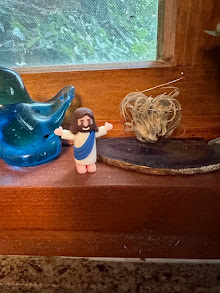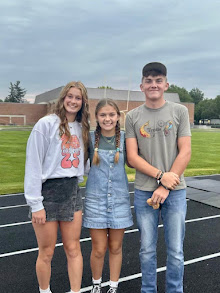 |
| Building terraces south of our house in 1987 |
Perhaps that was because the contrast between the flat farm ground of northern Illinois and the rock strewn landscape of central Missouri was so drastic. Tilling the big garden on the farm in Calloway county yielded a bountiful harvest of rocks. Clay and gravel were less than a spade length away; digging a post hole was a major endeavor. This wasn't soil: it was a foundation, a substrate; what it grew was trees, fossils, multiflora rose.....and fescue. Nonetheless, my father took his land stewardship very seriously, building ponds and seeding grass waterways on the thin chert ridden pasture ground.
So...imagine being transplanted to a place where ancestral winds piled up great mounds of glacial loam, where a drain spade slipped through the ground like a knife through butter...a place Lewis and Clark called the 'bald-pated prairie' after the tall grasses parting before the wind on either side of the great river.....
....A place where spring rains can run unabated through a tilled field, where a ditch will form anywhere a cow has walked two days in a row......a place so fertile...and so fragile...
No matter your landscape or your land use, the topsoil is a precious resource, one that takes generations to build up and but a few seasons to break down. Worlds reside within that thin upper crust: germination, decomposition, fertilization, aeration. The care and feeding of our soil is no small matter.
Long before the term 'no till' was common currency, soil conservation was a matter of structure, keeping the thin brown line in its place by reducing the velocity, the distance, and the slope of what forces moved against it. Terraces, tile lines, diversions, and waterways were the tools farmers and contractors employed before chemists, breeders and engineers gave us the means to leave the topsoil undisturbed while we planted, fertilized, sprayed and harvested. These long lived structures are costly, not quite the same magnitude as buying the kids a new pair of basketball shoes every year.
But our state cherishes its landscape: more than thirty years ago, the people of Missouri voted to pay a 1/10 cent sales tax dedicated to their State Parks and the conservation of Missouri soil and water. Since then this tax has been renewed three times, a measure of the confidence Missouri citizens have in the application and efficacy of these monies to lands public and private.
Like other farmers, our family has been pushing terraces, building basins, plowing up diversions, and practicing no till farming on our lands for as long as we have been farming. We are direct recipients of the generosity of Missouri taxpayers and we view the responsibility of maintaining and improving our soil as a calling, not a burden. To us, every broken terrace and every rutted field entrance is a challenge; after a generation of conservation tillage, we take pride when the combine ride across a terrace face is as smooth as the proverbial baby's cheek.
Here's the pitch and the promise: next week is Election Day 2016. Whatever your decisions about the rest of your ballot, please take time to vote for the renewal of the Missouri Soils, Water and State Parks Tax. Know that your vote will make the beautiful landscape and productive lands of our state better, as it has done since the first vote in 1984.
 |
| Terrace building Hurst Farms version, 1987 |
 |
| Plowing and pushing up terraces on our farm 1987 |















No comments:
Post a Comment